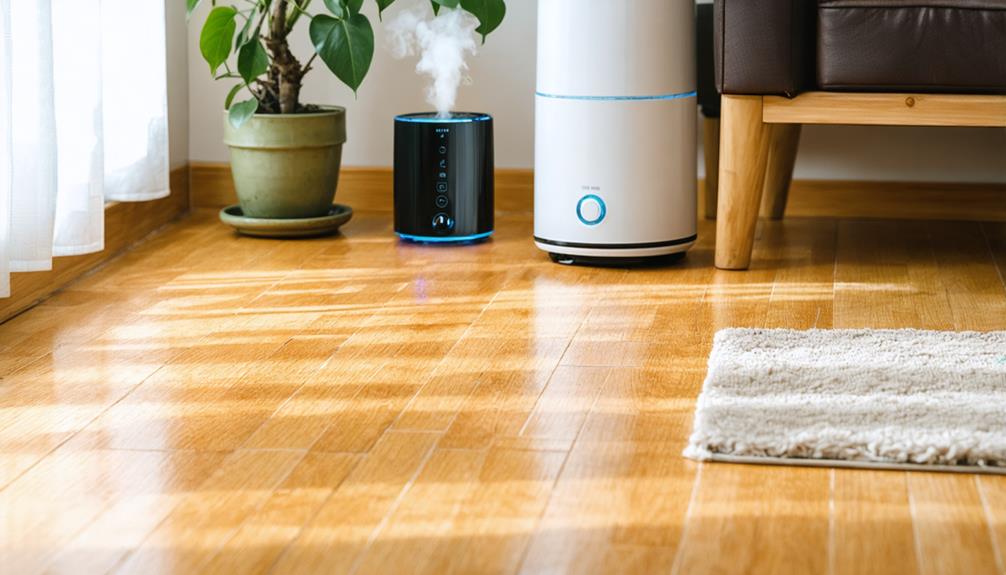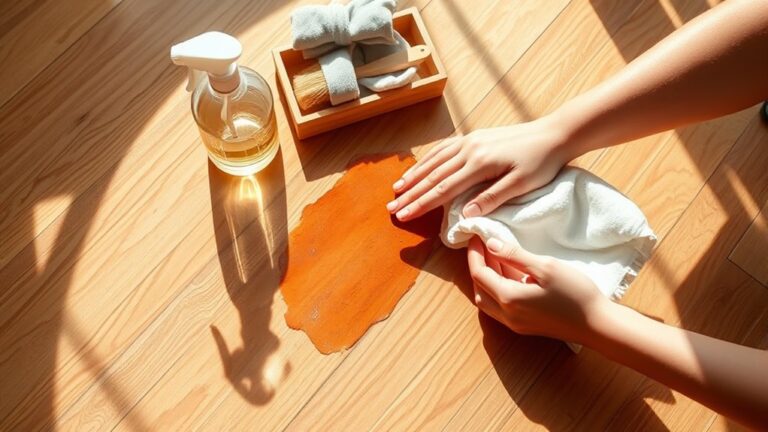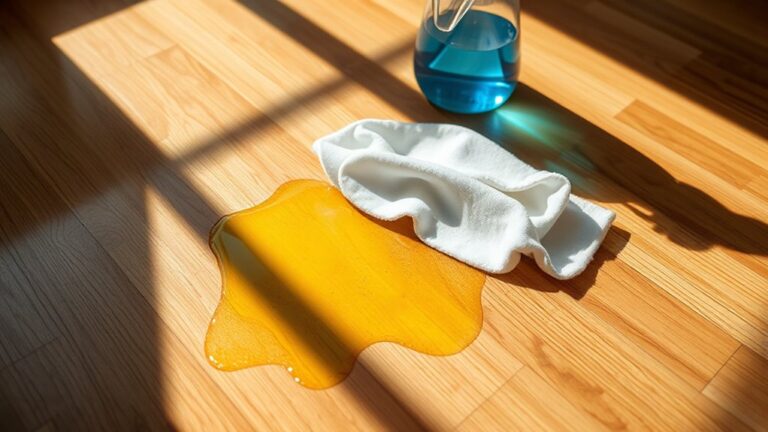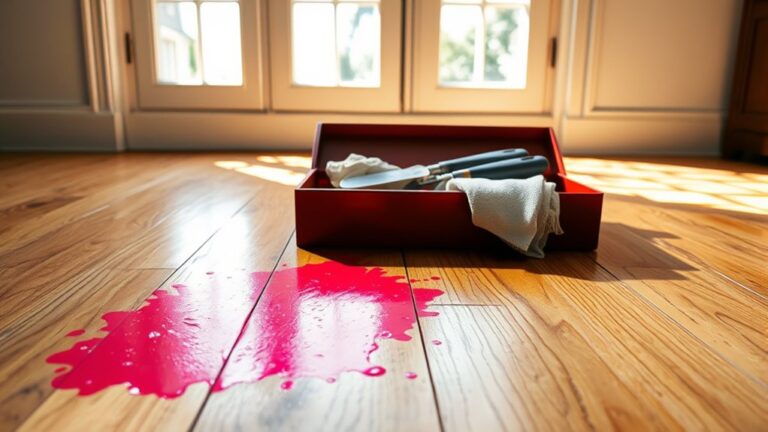To avoid bamboo floor cracking, you need to maintain humidity levels between 30-50%. Use humidifiers in dry conditions and place water bowls near heat sources to naturally increase moisture. Regularly monitor humidity with a hygrometer, as symptoms like cracks and shrinkage indicate low moisture. Additionally, set your heating between 68-72°F to prevent excessive drying. During installation, acclimate your bamboo flooring for at least a week and avoid extreme temperature fluctuations. Finally, perform regular cleaning and maintenance to keep your floors in good condition. There's much more to examine for ideal bamboo care.
Causes of Bamboo Floor Cracking
Bamboo floor cracking often occurs due to several environmental factors that can impact the material's integrity. One of the primary causes is low moisture levels in the air. When relative humidity drops below 30%, your bamboo flooring can suffer from excessive drying, leading to cracks. This is particularly problematic in desert climates, where humidity levels can plummet to below 20%.
Bamboo is a natural material that responds to changes in temperature and humidity by expanding and contracting. During dry, cold conditions, the risk of cracking increases considerably. If you're using heating systems set too high or relying heavily on air conditioning, you could be inadvertently worsening the moisture levels and contributing to the deterioration of your bamboo flooring.
Another factor to take into account is the acclimatization process. Before installation, bamboo flooring requires at least a week to adjust to the surrounding environment's humidity. If this step is neglected, the flooring might not properly acclimate, heightening the risk of cracking once it's laid down.
Understanding these causes can empower you to take proactive measures. Maintaining ideal humidity levels and ensuring proper acclimatization before installation are essential steps in preserving your bamboo flooring's integrity. By staying aware of these environmental influences, you can enjoy the beauty of bamboo flooring without the hassle of cracks.
Understanding Bamboo Behavior
When it comes to flooring, understanding how natural materials react to their environment is essential. Bamboo flooring, while beautiful and eco-friendly, is particularly sensitive to changes in moisture levels. This grass-like material expands when exposed to warm, humid conditions, absorbing moisture, and contracts in colder, dry weather, losing moisture.
To maintain the integrity of your bamboo flooring, you should aim for consistent indoor humidity levels between 30-50%. This range helps prevent issues like cracking and warping. If humidity drops below 20%, you might notice visible cracks as the bamboo dries out and loses its moisture balance. It's important to recognize that minor fluctuations in temperature and humidity are normal; these typically won't cause long-lasting damage. However, excessive humidity can lead to swelling and other problems, so striking a balance is critical.
To protect your flooring, monitor humidity levels with a hygrometer and consider using a humidifier or dehumidifier as necessary. Additionally, avoid placing bamboo flooring in areas prone to extreme moisture, like bathrooms or basements, unless properly treated. By being proactive and maintaining the right moisture levels, you can enjoy the beauty of bamboo flooring without the worry of cracks or warping. Understanding bamboo behavior in relation to environmental conditions will empower you to make informed decisions about your flooring care and maintenance.
Signs of Low Humidity
Maintaining proper humidity levels is vital for the longevity of bamboo flooring, as insufficient moisture can lead to visible signs of distress. One of the most noticeable indicators of low humidity is the presence of cracks in the bamboo planks. These cracks signal that the moisture content in the environment is inadequate, compelling you to increase humidity levels.
Dry air conditions, often exacerbated by heating systems or air conditioning, can greatly hinder bamboo's ability to maintain its necessary moisture balance. When humidity levels drop below 20%, the risk of damage escalates, leading to shrinkage and further cracking. Alongside visible cracks, you may also observe signs of shrinkage in the flooring, highlighting the urgency to restore adequate humidity levels in your home.
Regular monitoring of humidity is essential. Ideally, you should maintain humidity levels between 30-50% to guarantee the health of your bamboo flooring. You can achieve this through the use of humidifiers or by placing water trays near heat sources.
If you notice cracks or shrinkage, don't ignore them, as these are clear signs that the moisture content in your environment isn't supportive of your bamboo flooring. Taking proactive measures to address low humidity not only enhances the aesthetic appeal of your floors but also extends their lifespan. Remember, a small adjustment in humidity can make a meaningful difference in the overall condition of your bamboo flooring.
Remedies for Cracked Floors
To effectively remedy cracked bamboo floors, you need to focus on increasing indoor humidity and monitoring temperature settings. Using humidifiers or placing water bowls near heat sources can help maintain moisture levels. Regular maintenance is essential, so keep an eye on humidity fluctuations to prevent further damage.
Increase Indoor Humidity
Bamboo flooring can suffer from significant cracking if indoor humidity levels drop too low, making it essential to maintain a balanced moisture environment. To prevent damage, aim for humidity levels between 30-50%. When humidity falls below 20%, you risk severe issues with your bamboo floors.
One effective way to increase indoor humidity is by using a humidifier. This device can consistently raise moisture levels, ensuring your bamboo doesn't dry out and crack. Additionally, placing bowls of water near heat sources or radiators can naturally boost humidity in the air. This simple method helps restore the moisture balance essential for the longevity of your flooring.
Regularly monitoring your indoor humidity with a hygrometer allows you to identify low humidity conditions before they cause damage. By keeping an eye on these levels, you can take proactive measures to protect your bamboo floors. Finally, avoiding extreme temperature settings in your heating and cooling systems can further help regulate humidity levels, reducing the risk of cracking. By implementing these strategies, you can maintain a healthy humidity level and extend the life of your bamboo flooring.
Monitor Temperature Settings
Humidity management is closely linked to temperature control, as extreme heat can greatly lower moisture levels in your home, leading to potential cracking of your bamboo floors. To prevent this, it is crucial to monitor your temperature settings meticulously. Ideally, keep your heating system set between 68-72°F. This range helps maintain a favorable balance of humidity and prevents excessive drying of bamboo planks during colder months.
Here's a quick reference table to help you understand the effects of temperature settings:
| Temperature Setting | Effect on Humidity | Risk of Cracking |
|---|---|---|
| Below 68°F | Higher humidity | Low risk |
| 68-72°F | Balanced humidity | Minimal risk |
| Above 72°F | Lower humidity | Increased risk |
| Direct heat source | Dries out flooring | High risk |
Avoid placing heating vents directly on bamboo floors, as direct heat exacerbates moisture loss. Utilizing programmable thermostats can help regulate your indoor temperature settings, preventing sudden fluctuations that negatively impact your flooring. Regularly check and adjust your heating system to make sure it operates efficiently without causing excessive dryness.
Regular Floor Maintenance
Regular maintenance plays an essential role in preserving the integrity of your bamboo floors and preventing cracking. To guarantee your floors remain in top condition, maintain indoor humidity levels between 30-50%. If you notice your air is too dry, using humidifiers during dry seasons or placing bowls of water near heat sources can help introduce moisture, countering dryness effectively.
It's equally important to routinely check and adjust your heating and cooling systems. Avoid extreme temperature settings that can lead to fluctuations in humidity, which directly affect your bamboo flooring's stability. When cleaning, opt for non-abrasive products specifically designed for bamboo. Avoid steam cleaners, as they can introduce excessive moisture, potentially causing damage.
Scheduling periodic inspections of your bamboo floors is also critical. By identifying early signs of damage, you can implement maintenance measures before issues escalate. Regular floor maintenance not only prolongs the life of your bamboo flooring but also keeps it looking beautiful. Emphasizing these practices will help you enjoy your floors without the worry of cracking or other damage.
Maintenance Best Practices
To keep your bamboo flooring in top shape, it's essential to stay on top of maintenance best practices. Maintaining ideal conditions and using appropriate cleaning methods can greatly extend the life of your floor and prevent cracking. Here are some essential tips to follow:
- Monitor Humidity: Keep indoor humidity levels between 30-50%. This balance helps prevent your bamboo flooring from drying out and cracking due to low moisture content.
- Control Temperature Fluctuations: Regularly check and adjust your heating and cooling systems. Extreme temperature changes can exacerbate cracking in bamboo floors.
- Use Appropriate Cleaners: Opt for non-abrasive cleaning products specifically designed for bamboo flooring. Harsh chemicals can damage the surface and compromise the floor's integrity over time.
Additionally, it's wise to schedule periodic inspections. This allows you to identify early signs of damage, such as small cracks or shrinkage, enabling timely corrective measures. Implementing preventative strategies, like placing rugs or mats in high-traffic areas, can further reduce wear and tear on your bamboo flooring.
Installation and Acclimatization
When installing bamboo flooring, you need to guarantee proper acclimatization for at least 7-10 days to reduce moisture-related issues. Maintain the relative humidity between 35-50% in the installation area and follow the manufacturer's guidelines to achieve ideal performance. Additionally, consider using engineered bamboo in moisture-prone areas for better stability.
Proper Acclimatization Duration
Acclimatization is a critical step in the successful installation of bamboo flooring, as it allows the material to adapt to the local humidity levels. To guarantee peak performance and prevent cracking or warping, you should acclimate the bamboo for a minimum of 7 days before installation. In extreme climate conditions, extending the acclimatization period to 10 days may be necessary.
During this period, consider the following:
- Maintain a relative humidity of 30-50% in the installation area to facilitate proper acclimatization.
- Minimize temperature and humidity fluctuations to stabilize the bamboo planks effectively.
- Regularly monitor moisture content in both the bamboo and the subfloor to detect imbalances.
Installation Environment Considerations
Successful acclimatization sets the stage for ideal installation of bamboo flooring, but the environment in which you install it plays a significant role in its long-term performance. Making sure that your bamboo flooring acclimates for 7-10 days allows the material to adjust to local humidity levels, which is essential. You'll want to maintain indoor relative humidity between 30-50% before and after installation to prevent drying or cracking of the planks.
Before starting your installation, conduct moisture testing of the subfloor to verify it's within acceptable limits. This step is important for avoiding issues related to moisture imbalance that could compromise the flooring's integrity over time. Ideally, install your bamboo flooring during moderate weather conditions, steering clear of extremes in temperature and humidity that could stress the material.
Additionally, choose appropriate underlay materials that can accommodate moisture fluctuations, providing stability and minimizing the risk of cupping and cracking post-installation. By paying attention to these installation environment considerations, you'll set your bamboo flooring up for success, making sure it remains beautiful and functional for years to come.
Manufacturer Guidelines Adherence
Adhering to manufacturer guidelines during the installation and acclimatization of bamboo flooring is essential for guaranteeing its longevity and performance. This means taking the time to acclimate the flooring in your space for at least 7-10 days to align with the room's humidity levels. It's vital to conduct moisture testing of the subfloor using moisture meters before laying down the bamboo, as placing it over excessively damp or dry surfaces can set the stage for future cracking.
To guarantee proper installation, keep these key points in mind:
- Follow manufacturer specifications for underlayment and fasteners to provide adequate support.
- Maintain a consistent relative humidity level between 30-50% to facilitate bamboo's natural expansion and contraction.
- Adhere to temperature settings for heating and cooling systems, as excessive heat can lead to drying and cracking.
Environmental Considerations
Maintaining ideal humidity levels is essential for the longevity of bamboo flooring. It's critical to keep indoor humidity between 30-50% to prevent cracking. If humidity dips below 20%, you risk significant damage to your bamboo floors. Bamboo naturally expands in humid conditions and contracts when it's dry, so monitoring moisture levels is fundamental to avoid undue stress on the planks.
Heating systems, air conditioning, and open flames can lower indoor humidity, increasing the chances of bamboo cracking. You should adjust these systems to maintain moderate levels. Be particularly cautious during seasonal changes; heating seasons can cause rapid fluctuations in humidity. In these instances, using a humidifier might be necessary to safeguard your bamboo flooring against potential damage.
When selecting bamboo floors, consider environmental factors like geographic location and climate. Arid regions can exacerbate the challenges of maintaining proper humidity, influencing the durability and maintenance needs of your flooring. Being aware of your environment allows you to take proactive measures that protect your investment.
Cleaning and Care Tips
To keep your bamboo floors looking their best, it is crucial to implement a consistent cleaning and care routine. Proper maintenance not only enhances the aesthetic appeal of your flooring but also plays a critical role in preventing issues like cracking. Start by using non-abrasive cleaning products specifically designed for wood or bamboo. These products will help maintain the finish without causing damage.
Avoid using steam cleaners entirely; the heat and moisture can warp and crack the bamboo planks, leading to costly repairs. Instead, opt for a damp mop or a microfiber cloth for routine cleaning. Additionally, it is important to regularly monitor your indoor humidity levels, aiming for a range between 30-50%. This balance helps keep your bamboo flooring stable and greatly reduces the risk of cracking.
To further protect your floors, consider the following care tips:
- Use rugs or mats in high-traffic areas to minimize wear and tear.
- Schedule periodic inspections to catch early signs of damage or moisture imbalance.
- Promptly address spills to prevent moisture from seeping into the bamboo and causing damage.
Manufacturer and Warranty Insights
Understanding manufacturer guidelines and warranty details is fundamental for safeguarding your bamboo flooring investment. Each manufacturer provides specific care instructions and limitations that are critical to follow in order to avoid warranty issues related to cracking. Without adhering to these guidelines, you might find your warranty voided when you need it most.
Many manufacturers offer warranty coverage that can include certain types of damage. Consequently, it's essential to understand the terms and conditions associated with your warranty before making any claims. Not all bamboo flooring products are created equally; variations in quality can greatly impact warranty claims. Familiarizing yourself with the manufacturer's reputation and product specifications will equip you to make informed decisions.
Engaging with the retailer or manufacturer about environmental factors like humidity and temperature is another fundamental step. These conversations will clarify responsibilities concerning any cracking issues that arise. If problems do occur, documenting the conditions and any correspondence with the manufacturer will strengthen your position for warranty claims or potential replacements.
Frequently Asked Questions
How to Stop Bamboo Flooring From Creaking?
You might think creaking floors are just a normal part of owning bamboo flooring, but they can signal deeper issues. To tackle this, consider some effective creaking solutions. First, check for loose nails or fasteners; securing them can reduce friction. Next, use wood shims to fill any gaps between the subfloor and joists. Finally, applying construction adhesive in small gaps can stabilize planks, minimizing movement and resulting noise over time.
What Should You Not Put on a Bamboo Floor?
When considering what not to put on a bamboo floor, you should avoid using steam cleaners, abrasive products, and rubber-backed mats. These can damage the surface and trap moisture, leading to deterioration. Additionally, heavy furniture without floor protection can create indentations and stress fractures. Always make certain you're using protective pads under furniture and keep spills to a minimum to maintain the integrity of your bamboo flooring.
Does Bamboo Flooring Need a Vapor Barrier?
Think of your bamboo flooring as a delicate garden; it thrives with proper care. Yes, bamboo flooring needs a vapor barrier, especially if you're installing it over concrete. This barrier acts as a shield against moisture, essential for effective moisture management. Without it, you're inviting potential damage that could warp or crack your beautiful planks. So, invest in a durable polyethylene barrier to maintain your flooring's integrity and longevity.
What Causes Bamboo Flooring to Separate?
Bamboo flooring can separate due to moisture fluctuations, primarily caused by low humidity levels. When indoor humidity dips below 30%, the bamboo tends to contract, leading to gaps between planks. Rapid temperature changes further exacerbate this issue, causing the material to expand and contract unpredictably. Additionally, improper acclimatization during installation can prevent the flooring from adjusting properly to your home's environment, increasing the risk of separation over time.




